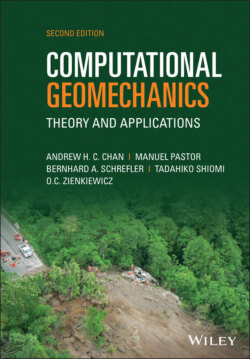Читать книгу Computational Geomechanics - Manuel Pastor - Страница 33
2.5.5 General Field Equations
ОглавлениеThe macroscopic balance laws are now transformed and the constitutive equations introduced, to obtain the general field equations.
The linear momentum balance equation for the fluid phases is obtained first. In Equation (2.65), the fluid acceleration is expressed, taking into account Equation (2.59), and introducing the relative fluid acceleration aπs. Further, Equations (2.67) and (2.68) are introduced. The terms dependent on the gradient of the fluid velocity and the effects of phase change are neglected and a vector identity for the divergence of the stress tensor is used. Finally, Equations (2.73) and (2.74) are included, yielding
(2.76)
The linear momentum balance equation for the solid phase is obtained in a similar way, taking into account Equations (2.68) instead of (2.67).
By summing this momentum balance equation with Equation (2.76) written for water and air and by taking into account the definition of total stress (2.69), assuming continuity of stress at the fluid‐solid interfaces and by introducing the averaged density of the multiphase medium
(2.77)
we obtain the linear momentum balance equation for the whole multiphase medium
(2.78)
The mass balance equations are derived next.
The macroscopic mass balance equation for the solid phase (2.61), after differentiation and dividing by ρs is obtained as
(2.79)
This equation is used in the subsequent mass balance equations to eliminate the material time derivative of the porosity. For incompressible grains, as assumed here, . For compressible grains, see Equation (2.89) and related remarks.
The mass balance equation for water (2.63) is transformed as follows. First in Equation (2.75), the material time derivative of the water density with respect to the moving solid phase and the relative velocity vws are introduced. Then the derivatives are carried out, the quantity of water lost through evaporation is neglected and the material time derivative of the porosity is expressed through Equation (2.79), yielding
(2.80)
The mass balance equation for air is derived in a similar way
(2.81)
To obtain the equations of Section 2.4.2, further simplifications are needed, which are introduced next.
An updated Lagrangian framework is used where the reference configuration is the last converged configuration of the solid phase. Further, the strain increments within each time step are small. Because of this, we can neglect the convective terms in all the balance equations. Neglecting in the linear momentum balance Equation (2.78) further the relative accelerations of the fluid phases with respect to the solid phase yields the equilibrium Equation (2.34a)
(2.82)
The linear momentum balance equation for fluids (2.76) by omitting all acceleration terms, as in Section 2.2.2, can be written for water
(2.83)
where
and
(2.84)
and for air
(2.85)
where
and
(2.86)
The phase densities appearing in Sections 2.2–2.4 are intrinsic phase averaged densities as indicated above.
The mass balance equation for water is obtained from Equation (2.80), taking into account the reference system chosen, dividing by ρw, developing the divergence term of the relative velocity and neglecting the gradient of water density. This yields
(2.87)
where the first of Equation (2.84) has been taken into account. This coincides with Equation (2.41a) for incompressible grains (α = 1) except for the source term and the second‐order term due to the change in fluid density. This last one could be introduced in the constitutive relationship (2.75).
Similarly, the mass balance equation for air becomes
(2.88)
where again the first of Equation (2.86) has been taken into account and the gradient of water density has been neglected. Similar remarks as for the water mass balance equation apply. In particular, the constitutive relationships for moist air, Equations (2.70) and (2.71), have been used.
Finally, if, for the solid phase, the following constitutive relationship is used (viz. Lewis and Schrefler 1998)
(2.89)
where Ks is the bulk modulus of the grain material, then the mass balance equations are obtained in the same form as in Section 2.4 (with χw = Sw), though this is not in agreement with what was assumed here for the effective stress.
